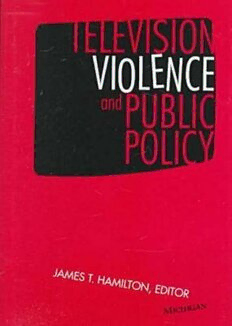Download Television Violence and Public Policy PDF Free - Full Version
Download Television Violence and Public Policy by James T. Hamilton in PDF format completely FREE. No registration required, no payment needed. Get instant access to this valuable resource on PDFdrive.to!
About Television Violence and Public Policy
Since 1954, violence in television programming has been the subject of legislative debate, congressional hearings, agency pronouncements, and presidential commentary. Most recently, ratings of television programs have been discussed and implemented while other means of controlling the access to certain kinds of television programs have been discussed. The debate over the age-based program rating system recently implemented by the television industry has generated many questions about television violence.The essays in the volume provide answers to many of these questions on specific policy issues surrounding media violence. The contributors suggest that the research on television violence can serve as the basis for a framework that categorizes programs based on the context in which the violence is presented. The manner in which information is conveyed about violent content affects how viewers react to such warnings. Program warnings with MPAA-style ratings have the potential to confuse parents (since they do not provide detailed content information) and attract some viewers such as teenage males.The contributors include some of the top researchers in the field of communications, several of whom participated in the National Television Violence Study. Contributors are Eva Blumenthal, Joanne Cantor, Wayne Danielson, Ed Donnerstein, Tim Gray, Kristen Harrison, Cynthia Hoffner, Marlies Klijn, Marina Krcmar, Dale Kunkel, Dominic Lasorsa, Rafael Lopez, Dan Linz, Adriana Olivarez, James Potter, Stacy Smith, Matthew L. Spitzer, Ellen Wartella, D. Charles Whitney, and Barbara Wilson.This volume will be of interest to communications researchers, media policy experts, legal scholars, government and industry officials, and social scientists interested in media and television.James Hamilton is Director of the Program on Violence and the Media, Duke University.
Detailed Information
| Author: | James T. Hamilton |
|---|---|
| Publication Year: | 1998 |
| ISBN: | 9780472086993 |
| Pages: | 409 |
| Language: | English |
| File Size: | 63.532 |
| Format: | |
| Price: | FREE |
Safe & Secure Download - No registration required
Why Choose PDFdrive for Your Free Television Violence and Public Policy Download?
- 100% Free: No hidden fees or subscriptions required for one book every day.
- No Registration: Immediate access is available without creating accounts for one book every day.
- Safe and Secure: Clean downloads without malware or viruses
- Multiple Formats: PDF, MOBI, Mpub,... optimized for all devices
- Educational Resource: Supporting knowledge sharing and learning
Frequently Asked Questions
Is it really free to download Television Violence and Public Policy PDF?
Yes, on https://PDFdrive.to you can download Television Violence and Public Policy by James T. Hamilton completely free. We don't require any payment, subscription, or registration to access this PDF file. For 3 books every day.
How can I read Television Violence and Public Policy on my mobile device?
After downloading Television Violence and Public Policy PDF, you can open it with any PDF reader app on your phone or tablet. We recommend using Adobe Acrobat Reader, Apple Books, or Google Play Books for the best reading experience.
Is this the full version of Television Violence and Public Policy?
Yes, this is the complete PDF version of Television Violence and Public Policy by James T. Hamilton. You will be able to read the entire content as in the printed version without missing any pages.
Is it legal to download Television Violence and Public Policy PDF for free?
https://PDFdrive.to provides links to free educational resources available online. We do not store any files on our servers. Please be aware of copyright laws in your country before downloading.
The materials shared are intended for research, educational, and personal use in accordance with fair use principles.

